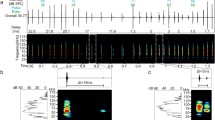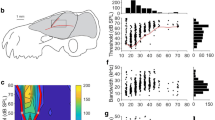Summary
-
1.
FM echolocating bats (Eptesicus fuscus) were trained to discriminate between a two-component complex target and a one-component simple target simulated by electronically-returned echoes in a series of experiments that explore the composition of the image of the two-component target. In Experiment I, echoes for each target were presented sequentially, and the bats had to compare a stored image of one target with that of the other. The bats made errors when the range of the simple target corresponded to the range of either glint in the complex target, indicating that some trace of the parts of one image interfered with perception of the other image. In Experiment II, echoes were presented simultaneously as well as sequentially, permitting direct masking of echoes from one target to the other. Changes in echo amplitude produced shifts in apparent range whose pattern depended upon the mode of echo presentation.
-
2.
Eptesicus perceives images of complex sonar targets that explicitly represent the location and spacing of discrete glints located at different ranges. The bat perceives the target's structure in terms of its range profile along a psychological range axis using a combination of echo delay and echo spectral representations that together resemble a spectrogram of the FM echoes. The image itself is expressed entirely along a range scale that is defined with reference to echo delay. Spectral information contributes to the image by providing estimates of the range separation of glints, but it is transformed into these estimates.
-
3.
Perceived absolute range is encoded by the timing of neural discharges and is vulnerable to shifts caused by neural amplitude-latency trading, which was estimated at 13 to 18 μs per dB from N 1 and N 4 auditory evoked potentials in Eptesicus. Spectral cues representing the separation of glints within the target are transformed into estimates of delay separations before being incorporated into the image. However, because they are encoded by neural frequency tuning rather than the time-of-occurrence of neural discharges, the perceived range separation of glints in images is not vulnerable to amplitudelatency shifts.
-
4.
The bat perceives an image that is displayed in the domain of time or range. The image receives no evident spectral contribution beyond what is transformed into delay estimates. Although the initial auditory representation of FM echoes is spectrogram-like, the time, frequency, and amplitude dimensions of the spectrogram appear to be compressed into an image that has only time and amplitude dimensions. The spectral information is not lost but manifests itself as equivalent time-domain information.
Similar content being viewed by others
References
Altes RA (1976) Sonar for generalized target description and its similarity to animal echolocation systems. J Acoust Soc Am 59:97–105
Altes RA (1980) Detection, estimation, and classification with spectrograms. J Acoust Soc Am 67:1232–1246
Altes RA (1981) Echo phase perception in bat sonar? J Acoust Soc Am 69:1232–1246
Altes RA (1984) Texture analysis with spectrograms. IEEE Trans Sonics Ultrasonics, SU-31: pp 407–417
Beuter KJ (1980) A new concept of echo evaluation in the auditory system of bats. In: Busnel R-G, Fish JF (eds) Animal sonar systems. Plenum Press, New York, pp 747–761
Bodenhamer RD, Pollak GD (1981) Time and frequency domain processing in the inferior colliculus of echolocating bats. Hearing Res 5:317–355
Bodenhamer RD, Pollak GD, Marsh DS (1979) Coding of the fine frequency information by echoranging neurons in the inferior colliculus of the Mexican free-tailed bat. Brain Res 171:530–535
Bradbury JW (1970) Target discrimination by the echolocating bat Vampyrum spectrum. J Exp Zool 173:23–46
Busnel R-G, Fish JF (1980) Animal sonar systems. Plenum Press, New York
Covey E, Casseday JH (1986) Connectional basis for frequency representation in the nuclei of the lateral lemniscus of the bat Eptesicus fuscus. J Neurosci 6:2926–2940
Dalland JI (1965) Hearing sensitivity in bats. Science 150:1185–1186
Feng AS, Simmons JA, Kick SA (1978) Echo detection and targetranging neurons in the auditory system of the bat Eptesicus fuscus. Science 202:645–648
Gardner RE, Garvey WT (1974) Directional sensitivity of the auditory system in bats producing FM signals. Honors thesis, Washington Univ., St. Louis
Griffin DR (1958) Listening in the dark. Yale Univ. Press, New Haven, CT (2nd ed., Cornell Univ. Press, Ithaca, NY, 1986)
Griffin DR (1967) Discriminative echolocation by bats. In: Busnel R-G (ed) Animal sonar systems: Biology and bionics, Laboratoire de physiologie acoustique, Jouy-en-Josas, France, pp 273–300
Griffin DR, Friend JH, Webster FA (1965) Target discrimination by the echolocation of bats. J Exp Zool 158:155–168
Habersetzer J, Vogler B (1983) Discrimination of surface-structured targets by the echolocating bat Myotis myotis during flight. J Comp Physiol 152:275–282
Henson OW Jr, Bishop AL, Keating AW, Kobler JB, Henson MM, Wilson BS, Hansen RC (1987) Biosonar imaging of insects by Pteronotus p. parnellii, the mustached bat. National Geographic Res 3:82–101
Jen PH-S, Sun X, Lin PJJ (1989) Frequency and space representation in the primary auditory cortex of the frequency modulating bat Eptesicus fuscus. J Comp Physiol A 165:1–14
Kick SA (1980) Target detection and the operational range of sonar in the bat, Eptesicus fuscus. Doctoral thesis, Washington Univ., St. Louis
Kick SA, Simmons JA (1984) Automatic gain control in the bat's sonar receiver and the neuroethology of echolocation. J Neurosci 4:2705–2737
Menne D, Kaipf I, Wagner I, Ostwald J, Schnitzler HU (1989) Range estimation by echolocation in the bat Eptesicus fuscus: trading of phase versus time cues. J Acoust Soc Am 85:2642–2650
Moss CF, Schnitzler HU (1989) Accuracy of target ranging in echolocating bats: acoustic information processing. J Comp Physiol A 165:383–393
Nachtigall P, Moore PWB (eds) (1988) Animal sonar: Processes and performance. Plenum Press, New York
Neuweiler G, Bruns V, Schuller G (1980) Ears adapted for the detection of motion, or how echolocating bats have exploited the capabilities of the mammalian auditory system. J Acoust Soc Am 68:741–753
O'Neill WE, Suga N (1982) Neural encoding of target range and its representation in the auditory cortex of the mustached bat. J Neurosci 47:225–255
Pollak GD, Marsh DS, Bodenhamer R, Souther A (1977) Characteristics of phasic on neurons in the inferior colliculus of unanesthetized bats with observations relating to mechanism for echo ranging. J Neurophysiol 40:926–941
Schmidt S (1988) Evidence for a spectral basis of texture perception in bat sonar. Nature 331:617–619
Schnitzler H-U, Henson OW Jr (1980) Performance of airborne animal sonar systems: I. Microchiroptera. In: R-G Busnel, JF Fish (eds) Animal sonar systems. Plenum Press, New York, pp 109–181
Schnitzler H-U, Menne D, Kober R, Heblich D (1983) The acoustical image of fluttering insects in echolocating bats. In: Huber F, Markl H (eds) Neuroethology and behavioral physiology: roots and growing points. Springer, Berlin Heidelberg New York, pp 235–250
Simmons JA (1973) The resolution of target range by echolocating bats. J Acoust Soc Am 54:157–173
Simmons JA (1979) Perception of echo phase information in bat sonar. Science 207:1336–1338
Simmons JA (1980) The processing of sonar echoes by bats. In: Busnel R-G, Fish JF (eds) Animal sonar systems. Plenum Press, New York, pp 695–714
Simmons JA (1987) Acoustic images of target range in the sonar of bats. Naval Res Rev 39:11–26
Simmons JA (1989) A view of the world through the bat's ear: the formation of acoustic images in echolocation. Cognition 33:155–199
Simmons JA, Chen L (1989) The acoustic basis for target discrimination by FM echolocating bats. J Acoust Soc Am 86:1333–1350
Simmons JA, Grinnell AD (1988) The performance of echolocation: Acoustic images perceived by echolocating bats. In: Nachtigall PE, Moore PWB (eds) Animal sonar: Processes and performance. Plenum Press, New York, pp 353–385
Simmons JA, Kick SA (1984) Physiological mechanisms for spatial filtering and image enhancement in the sonar of bats. Ann Rev Physiol 46:599–614
Simmons JA, Lavender WA (1976) Representation of target range in the sonar receivers of echolocating bats. J Acoust Soc Am Suppl 60:S5
Simmons JA, Stein RA (1980) Acoustic imaging in bat sonar: Echolocation signals and the evolution of echolocation. J Comp Physiol 135:61–81
Simmons JA, Vernon JA (1971) Echolocation: discrimination of targets by the bat Eptesicus fuscus. J Exp Zool 176:315–328
Simmons JA, Lavender WA, Lavender BA, Doroshow CA, Kiefer SW, Livingston R, Scallet AC, Crowley DE (1974) Target structure and echo spectral discrimination by echolocating bats. Science 186:1130–1132
Simmons JA, Fenton MB, Ferguson WR, Jutting M, Palin J (1979) Apparatus for research on animal ultrasonic signals. Royal Ontario Museum Publ Life Sci, Toronto
Simmons JA, Ferragamo M, Moss CF, Stevenson SB, Altes RA Discrimination of jittered sonar echoes by the echolocating bat, Eptesicus fuscus: The shape of target images in echolocation. J Comp Physiol A (in press)
Simmons JA, Freedman EG, Stevenson SB, Chen L, Wohlgenant TJ (1989) Clutter interference and the integration time of echoes in the echolocating bat, Eptesicus fuscus. J Acoust Soc Am 86:1318–1332
Suga N (1970) Echo-ranging neurons in the inferior colliculus of bats. Science 170:449–452
Suga N (1988) Auditory neuroethology and speech processing: Complex-sound processing by combination-sensitive neurons. In: Edelman GM, Gall WE, Cowan WM (eds) Auditory function. Wiley, New York, pp 679–720
Suga N, Horikawa J (1986) Multiple time axes for representation of echo delays in the auditory cortex of the mustached bat. J Neurophysiol 55:776–806
Suga N, Jen PH-S (1977) Further studies on the peripheral auditory system of “CF-FM” bats specialized for fine frequency analysis of Doppler-shifted echoes. J Exp Biol 69:207–232
Suga N, O'Neill WE (1979) Neural axis representing target range in the auditory cortex of the mustache bat. Science 206:351–353
Sullivan WE (1982) Neural representation of target distance in auditory cortex of the echolocating bat Myotis lucifigus. J Neurophysiol 48:1011–1032
Sum YW, Menne D (1988) Discrimination of fluttering targets by the FM-Bat Pipistrellus stenopterus? J Comp Physiol A 163:349–354
Suthers RA, Wenstrup JJ (1987) Behavioral discrimination studies involving prey capture by echolocating bats. In: Fenton MB, Racey PA, Rayner JMV (eds) Recent advances in the study of bats. Cambridge Univ Press, Cambridge
Trappe M (1982) Verhalten und Echoortung der Grossen Hufeisennase (Rhinolophus ferrumequinum) beim Insektenfang. Ph.D. Thesis, Univ. Marburg
Van Trees HL (1971) Detection, estimation, and modulation theory, part III. Wiley, New York
von der Emde G, Menne D (1989) Discrimination of insect wingbeat frequencies by the bat Rhinolophus ferrumequinum. J Comp Physiol A 164:663–671
Webster FA, Griffin DR (1962) The role of the flight membrane in insect capture by bats. Anim Behav 10:332–340
Wong D, Shannon SL (1988) Functional zones in the auditory cortex of the echolocating bat, Myotis lucifigus. Brain Res 453:349–352
Author information
Authors and Affiliations
Rights and permissions
About this article
Cite this article
Simmons, J.A., Moss, C.F. & Ferragamo, M. Convergence of temporal and spectral information into acoustic images of complex sonar targets perceived by the echolocating bat, Eptesicus fuscus . J Comp Physiol A 166, 449–470 (1990). https://doi.org/10.1007/BF00192016
Accepted:
Issue Date:
DOI: https://doi.org/10.1007/BF00192016




